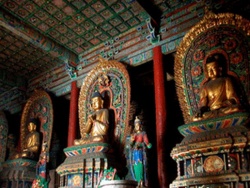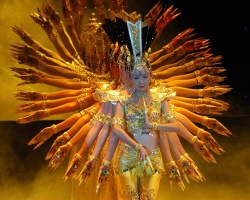Difference between revisions of "Korean Philosophy"
(Created page with "thumb|250px| <poem> Korean Philosophy has been influenced by a number of religious and philosophical thought-systems over the years, including Shamanism, ...") |
|||
| (6 intermediate revisions by 2 users not shown) | |||
| Line 1: | Line 1: | ||
[[File:Mple-1.JPG|thumb|250px|]] | [[File:Mple-1.JPG|thumb|250px|]] | ||
| − | + | ===Introduction=== | |
| − | |||
| − | |||
| − | + | [[Korean]] [[Philosophy]] has been influenced by a number of [[religious]] and [[philosophical]] thought-systems over the years, including {{Wiki|Shamanism}}, [[Buddhism]], {{Wiki|Confucianism}} and {{Wiki|Taoism}}: | |
| − | |||
| − | + | === History and Major Schools === | |
| + | |||
| + | '''Native {{Wiki|shamanism}}''' developed in [[Korea]] for millennia, although the [[traditional]] [[rites]] and {{Wiki|shamanistic}} practices were later deeply influenced by [[Buddhism]] and {{Wiki|Taoism}}. In [[Korea]], a {{Wiki|shaman}} is known as a [[mudang]], and she (it is usually a woman) seeks to solve [[human]] problems through a connection to the [[spirit world]]. [[Korean]] {{Wiki|Shamanism}} held three [[spirits]] in especially high regard: [[Sanshin]] (the [[Mountain Spirit]]), [[Toksong]] (the [[Recluse]]) and [[Chilsong]] (the [[Spirit of the Seven Stars]], the [[Big Dipper]]). | ||
| + | |||
| + | '''[[Buddhism]]''' arrived in [[Korea]] from [[China]] during the {{Wiki|Three Kingdoms}} period (57 B.C. - A.D. 668), specifically in the year A.D. 372. [[Korean Buddhism]] accepted and absorbed many {{Wiki|shamanistic}} [[spirits]], and [[early schools]] like [[Samnon]], [[Gyeyul]] and [[Yeolban]] attempted to develop a new {{Wiki|holistic}} approach to [[Buddhism]] in [[order]] to resolve what it saw as internal inconsistencies in {{Wiki|Chinese}} [[Mahayana Buddhism]]. | ||
| + | |||
| + | Soon [[Wonyung]] (later known as [[Hwaeom]]) became the dominant school and then, in the 7th and 8th Century and after, the meditation-based [[Seon school]] finally gained the upper hand. [[Seon]] is a version of the {{Wiki|Chinese}} [[Chan]] (or {{Wiki|Japanese}} [[Zen]]) [[Buddhism]], and it developed in [[Korea]] particularly under the [[direction]] of [[Jinul]] (1158-1210), the most important figure in [[Seon]]. | ||
| + | |||
| + | [[Buddhism]] in [[Korea]] initially enjoyed wide [[acceptance]], even [[being]] supported as the [[state]] ideology during the [[Goryeo Dynasty]] (also known as [[Koryo]]: 918-1392), but it [[suffered]] extreme repression during the long {{Wiki|Joseon}} Dynasty (or [[Chosun]]: 1392-1910), when [[Neo-Confucianism]] became dominant. | ||
| + | |||
| + | '''{{Wiki|Confucianism}}''' was the second major [[intellectual]] import from [[China]] during the {{Wiki|Three Kingdoms}} period, alongside [[Buddhism]], although the exact date of its introduction is not clear. | ||
| + | |||
| + | [[Korean]] {{Wiki|Confucianism}} was, and remains, a fundamental part of [[Korean]] {{Wiki|society}}, shaping the [[moral]] system, the way of [[life]], {{Wiki|social}} relations between old and young, high {{Wiki|culture}} and is the basis for much of the [[Korean]] legal system. During the {{Wiki|Joseon}} Dynasty, [[Korean]] {{Wiki|Confucianism}} (or, arguably, [[Neo-Confucianism]]) was the [[primary]] system of [[belief]] amongst the [[scholarly]] and {{Wiki|military}} classes. | ||
| + | |||
| + | |||
| + | |||
| + | [[Korean]] {{Wiki|Confucian}} schools were built, and there was even greater encouragement of {{Wiki|Confucian}} [[ideas]] and ideals such as [[chung]] (loyalty), [[hyo]] (filial piety), in ([[benevolence]]) and [[sin]] ([[trust]]). | ||
| + | |||
| + | {{Wiki|Confucianism}} in {{Wiki|Joseon}} [[Korea]] flourished most notably in the 16th Century, under the guidance of the country's two most prominent {{Wiki|Confucian}} [[scholars]], [[Yi Hwang]] ([[Toegye]]) (1501–1570) and [[Yi I]] ([[Yulgok]]) (1536–1584). | ||
| + | |||
| + | '''{{Wiki|Taoism}}''', largely shaped by the writings of the {{Wiki|Chinese}} [[philosophers]] [[Lao Tzu]] and [[Chuang Tzu]], also arrived in [[Korea]] during the [[latter]] part of the {{Wiki|Three Kingdoms}} period, in A.D. 674. [[Korean Taoism]] enjoyed its greatest [[popularity]] during the [[Goryeo Dynasty]], especially in the court and the ruling class. | ||
| + | |||
| + | By the mid period of the [[Goryeo Dynasty]], however, [[Buddhism]] dominated [[Korea]], subsuming other [[religions]] and [[philosophies]], including {{Wiki|Taoism}}. {{Wiki|Taoism}} never grew into an autonomous [[religion]] or [[philosophy in Korea]], [[being]] rejected by {{Wiki|Confucian}} and [[Buddhist]] elites, but it remains a minor but significant [[element]] of [[Korean]] [[thought]]. | ||
| + | |||
| + | |||
| + | === {{Wiki|Modern}} {{Wiki|Era}} === | ||
| − | |||
| − | |||
[[File:Ncers500.jpg|thumb|250px|]] | [[File:Ncers500.jpg|thumb|250px|]] | ||
| − | Under Japanese rule, from 1910, Shintoism became the state religion, although Western philosophy, particularly the German Idealist philosophers which were in vogue in Japan at the time, was influential. After partition in 1945, North Korea's orthodox Marxism was loosely built on the Confucian yangban scholar-warriors of earlier times, and communist Maoism represents a latter day philosophical import from China. | + | Under {{Wiki|Japanese}} {{Wiki|rule}}, from 1910, {{Wiki|Shintoism}} became the [[state]] [[religion]], although {{Wiki|Western philosophy}}, particularly the {{Wiki|German}} Idealist [[philosophers]] which were in vogue in {{Wiki|Japan}} at the [[time]], was influential. After partition in 1945, [[North]] [[Korea's]] {{Wiki|orthodox}} [[Marxism]] was loosely built on the {{Wiki|Confucian}} [[yangban scholar-warriors]] of earlier times, and {{Wiki|communist}} [[Maoism]] represents a [[latter day]] [[philosophical]] import from [[China]]. |
| − | + | ||
{{R}} | {{R}} | ||
[http://www.philosophybasics.com/general_eastern_korean.html www.philosophybasics.com] | [http://www.philosophybasics.com/general_eastern_korean.html www.philosophybasics.com] | ||
[[Category:Buddhist Terms]] | [[Category:Buddhist Terms]] | ||
| − | [[Category: | + | [[Category:Korean Philosophy]] |
[[Category:Korea]] | [[Category:Korea]] | ||
Latest revision as of 02:59, 5 February 2015
Introduction
Korean Philosophy has been influenced by a number of religious and philosophical thought-systems over the years, including Shamanism, Buddhism, Confucianism and Taoism:
History and Major Schools
Native shamanism developed in Korea for millennia, although the traditional rites and shamanistic practices were later deeply influenced by Buddhism and Taoism. In Korea, a shaman is known as a mudang, and she (it is usually a woman) seeks to solve human problems through a connection to the spirit world. Korean Shamanism held three spirits in especially high regard: Sanshin (the Mountain Spirit), Toksong (the Recluse) and Chilsong (the Spirit of the Seven Stars, the Big Dipper).
Buddhism arrived in Korea from China during the Three Kingdoms period (57 B.C. - A.D. 668), specifically in the year A.D. 372. Korean Buddhism accepted and absorbed many shamanistic spirits, and early schools like Samnon, Gyeyul and Yeolban attempted to develop a new holistic approach to Buddhism in order to resolve what it saw as internal inconsistencies in Chinese Mahayana Buddhism.
Soon Wonyung (later known as Hwaeom) became the dominant school and then, in the 7th and 8th Century and after, the meditation-based Seon school finally gained the upper hand. Seon is a version of the Chinese Chan (or Japanese Zen) Buddhism, and it developed in Korea particularly under the direction of Jinul (1158-1210), the most important figure in Seon.
Buddhism in Korea initially enjoyed wide acceptance, even being supported as the state ideology during the Goryeo Dynasty (also known as Koryo: 918-1392), but it suffered extreme repression during the long Joseon Dynasty (or Chosun: 1392-1910), when Neo-Confucianism became dominant.
Confucianism was the second major intellectual import from China during the Three Kingdoms period, alongside Buddhism, although the exact date of its introduction is not clear.
Korean Confucianism was, and remains, a fundamental part of Korean society, shaping the moral system, the way of life, social relations between old and young, high culture and is the basis for much of the Korean legal system. During the Joseon Dynasty, Korean Confucianism (or, arguably, Neo-Confucianism) was the primary system of belief amongst the scholarly and military classes.
Korean Confucian schools were built, and there was even greater encouragement of Confucian ideas and ideals such as chung (loyalty), hyo (filial piety), in (benevolence) and sin (trust).
Confucianism in Joseon Korea flourished most notably in the 16th Century, under the guidance of the country's two most prominent Confucian scholars, Yi Hwang (Toegye) (1501–1570) and Yi I (Yulgok) (1536–1584).
Taoism, largely shaped by the writings of the Chinese philosophers Lao Tzu and Chuang Tzu, also arrived in Korea during the latter part of the Three Kingdoms period, in A.D. 674. Korean Taoism enjoyed its greatest popularity during the Goryeo Dynasty, especially in the court and the ruling class.
By the mid period of the Goryeo Dynasty, however, Buddhism dominated Korea, subsuming other religions and philosophies, including Taoism. Taoism never grew into an autonomous religion or philosophy in Korea, being rejected by Confucian and Buddhist elites, but it remains a minor but significant element of Korean thought.
Modern Era
Under Japanese rule, from 1910, Shintoism became the state religion, although Western philosophy, particularly the German Idealist philosophers which were in vogue in Japan at the time, was influential. After partition in 1945, North Korea's orthodox Marxism was loosely built on the Confucian yangban scholar-warriors of earlier times, and communist Maoism represents a latter day philosophical import from China.

